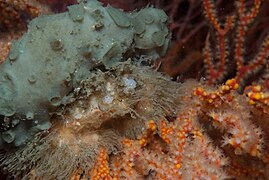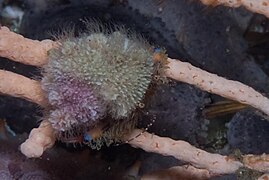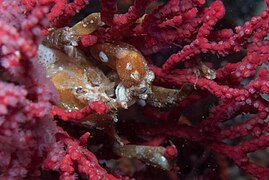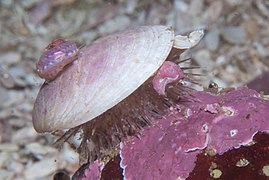The dive site Super Fan Reef is an inshore, rocky reef, in the Castle Rocks area on the west side of False Bay, near Cape Town in the Western Cape province of South Africa.
Understand
edit
This site is moderately deep, but shallow enough for a fairly long dive on nitrox. It is deep enough to avoid much of the surge if there is a moderate swell running, and makes a convenient alternative for days when the surge is a bit strong at the shallower sites. The site is small and can be visited comprehensively on one dive. It is quite a nice site with a lot of sea fans, and worth a visit at some time. The reef was found by Dave Smith and Georgina Jones in May 2021 on a dive for the iNaturalist City Nature Challenge, when the intended site (Fan Reef) about 200m to the northeast, was found to have very poor surface visibility.
Position
edit- S34°14.265’ E018°29.170' 1 Super Fan Reef
This site is in a Marine Protected Area (2004). A permit is required.
Name
editDepth
editMaximum depth is about 26 m at the far eastern outlier, and about 25 on the sand round the main ridge. The top of the main ridge is about 20 m. Average depth of a dive excluding ascent is likely to be about 24 m.
Visibility
editVisibility is likely to be similar to the neighbouring reefs, but has been known to differ, when the edge of a patch of dirty water covered Fan Reef, but did not extend as far as Super Fan Reef, just a couple of hundred metres away.
Topography
editA small patch of granite reef between Outer Castle, Giant's Castle, and Phone Reef. The main ridge is about 25 m long north to south and about 15 m east to west, with the top of the ridge at about 5 m above the sand, and a smaller section close by to the north, To the east is a parallel row of three lower outcrops. The reef is surrounded by flat sand bottom.
Geology: Granite corestone outcrops of the pre-Cambrian Peninsula pluton.
Conditions
editThe site is exposed to wind and waves from the south-east, so should be dived in reasonably flat seas or westerly swells. It is reasonably protected from westerly and south-westerly swells.
The site will usually be at it's best in winter but there will be opportunities in other seasons.
Get in
editThis is exclusively a boat dive: It is too far (roughly 1 km) offshore for most people to swim and is in a high boat-traffic zone as it is on the way from the nearby slipway at Miller's Point to most of the local fishing areas.
The site is approximately 1.9 km from Miller's Point slipway and 9.2km from Simon's Town jetty.
See
editMarine life
editThe site was named for the large number of sea fans on the reef, but there is quite a high diversity for a small reef, probably because it is right in the middle of a large area of diverse reef, with only a short distance over the sand to both deeper and shallower reef in most directions. Unsurprisingly, quite a number of basket stars have been seen, mostly on the sea fans, which is a common place to find them.
- shaggy sponge crab, Dromidia hirsutissima, on a sea fan Melithaea rubra
- Tiny basket star on a palmate sea fan
- blue-striped hermit crab with shell-mimic hydroid on nippled sea fan
- toothed decorator crab on multicoloured sea fan
- Cape long-legged spidercrab on palmate sea fan
- The beautiful starfish Callopatiria formosa in 23 m of water
- Pleated fan worm genus Myxicola
- Cape urchin Parechinus angulosus with 'hat'
- Two-eyed blenny Chalaroderma ocellata in an abandoned worm tube
- Underside of a basket star on a sea fan
Photography
editAs is the case with most of the local reefs, macro photography is likely to deliver the most consistent results. Artificial light will be necessary for macro, and useful for any reasonably close subjects.
Suggested routes
editThere are no special routes recommended. Start deep and work your way up as available no-stop time decreases. It is possible to do a no-stop dive for an hour on a single cylinder on nitrox.
Stay safe
editHazards
editNo site-specific hazards other than moderate to fairly heavy boat traffic in the vicinity.
Skills
editThe site is too deep for entry level divers. There is very little reef above 18m. The ability to deploy a DSMB is strongly recommended in case you need to surface away from the shotline.
Equipment
editA DSMB and reel or spool is recommended to warn boats of your presence while ascending, and to help your skipper find you after the dive. Nitrox can extend your dive time significantly in this depth range.
Nearby
edit- 1 Miller's Point tidal pool
- 2 Murphy's
- 3 Boat Rock
- 4 Festival Pinnacle
- 5 Fan Reef
- 6 Shark Alley
- 7 Pyramid Rock
- 8 Phone Reef
- 9 Outer Castle
- 10 Giant's Castle
- 11 Zigzag Reef
- 12 North Pie Rock Reef
- 13 West Pie Rock Reef
- 14 Castle Rocks Point Reefs
- 15 South Pie Rock Pinnacles
Back to the Alphabetical list of sites, or list of dive sites in the Castle Rocks area
Other regional dive sites:
- Dive sites of Table Bay and approaches,
- Dive sites of the Cape Peninsula west coast
- Dive sites of False Bay offshore and approaches
- Dive sites of False Bay east coast
- Fresh water dive sites of the Cape Town Metropolitan Area















